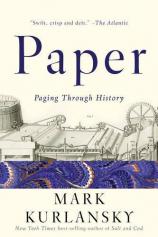Paper: A World History
Review
Paper: A World History
One might expect a history of paper to be a little dry. Perhaps a tad flat. But leave it to Mark Kurlansky, whose previous bestselling microhistories include COD and SALT, to make the history of paper --- or, rather, history through paper --- both engaging and three-dimensional.
Kurlansky doesn’t just trace the history of paper’s invention, manufacture and use (although he does all those things). Instead, he uses his exploration of paper as a way to examine a number of different cultures throughout history, learning how the utilization of paper intersected with those cultures’ need and desire for technological change.
"[Kurlansky's] fascinating consideration of the changing role of paper, printing and the written word offers readers numerous opportunities to consider how the debates of our own time fit in with the long evolution of human communication and the technology surrounding it."
Throughout, Kurlansky takes on what he calls the “technological fallacy,” the notion that advances in technology fundamentally change society. Instead, he argues throughout his history, “society develops technology to address the changes that are taking place within it.” He points out, for example, that in most cultures, the impetus for first developing or adopting the use of paper was the need for more sophisticated methods of accounting. In societies like the Mayans, who had a quite accurate method of using knotted strings for accounting, their satisfaction with existing methods meant that paper was adopted later, if at all. Similarly, Kurlansky shows that paper did not cause the Renaissance or the Reformation in Europe. Instead, paper was simply an effective and efficient means of helping to capture the spirit of creation and questioning of religious authority that was already coursing through European society at that time.
Although Kurlansky does an admirable job of covering a large swathe of human history, from ancient Egypt and China to the present day, and although he also clearly describes the different methods used for making paper throughout history, readers are perhaps most likely to pause and think about the small details with which he punctuates his narrative. They include the difficulty of creating a system of printing with moveable type for a language like Chinese with tens of thousands of characters, and the myriad ways in which paper, particularly the ability to execute sketches and studies, fundamentally changed the way artists approached their work.
Throughout his history, Kurlansky points out instances where naysayers bemoaned new technological advances around paper, complaining, for example, that a written language would almost certainly result in the diminishment of people’s ability to remember texts such as long poems, which formerly had been shared orally. It’s worth keeping those centuries of skeptics in mind as Kurlansky brings his account up to the present day and delves into some of the current debates around the paperless society, the demise of printed books and newspapers, and so forth. His fascinating consideration of the changing role of paper, printing and the written word offers readers numerous opportunities to consider how the debates of our own time fit in with the long evolution of human communication and the technology surrounding it.
Reviewed by Norah Piehl on May 13, 2016
Paper: A World History
- Publication Date: May 23, 2017
- Genres: History, Nonfiction
- Paperback: 416 pages
- Publisher: W. W. Norton & Company
- ISBN-10: 0393353702
- ISBN-13: 9780393353709





